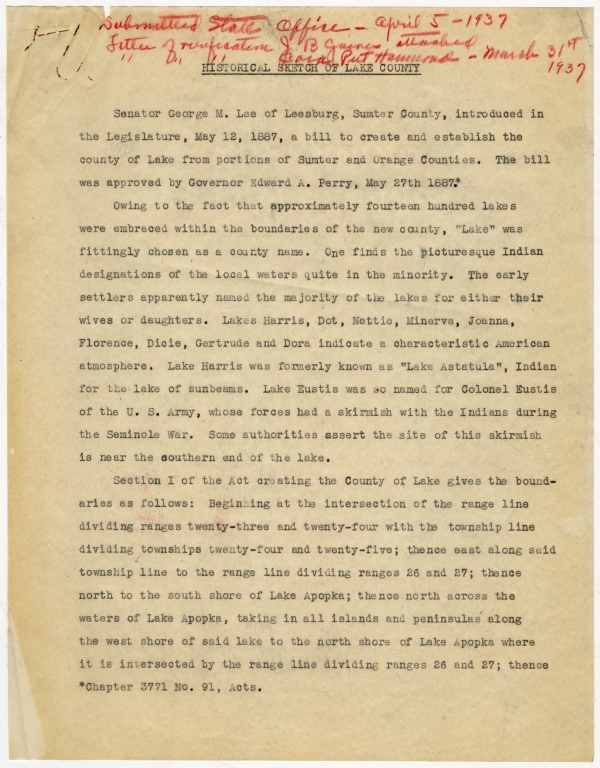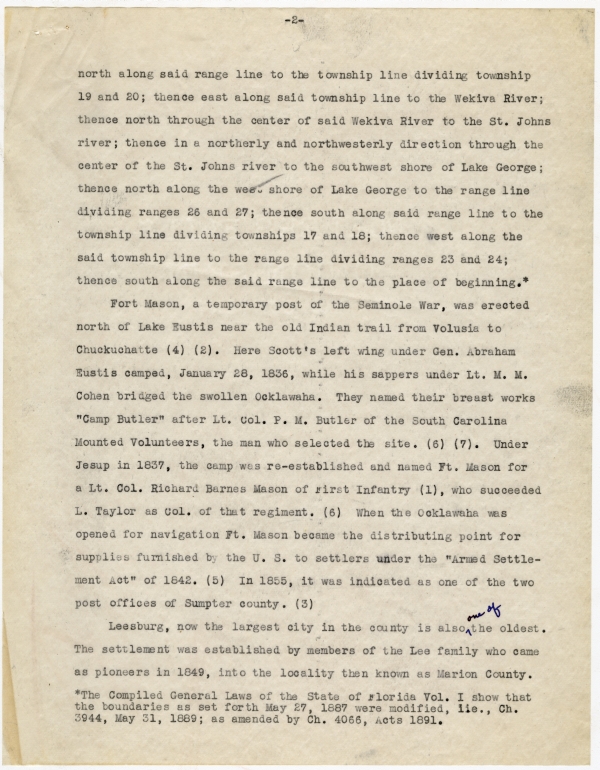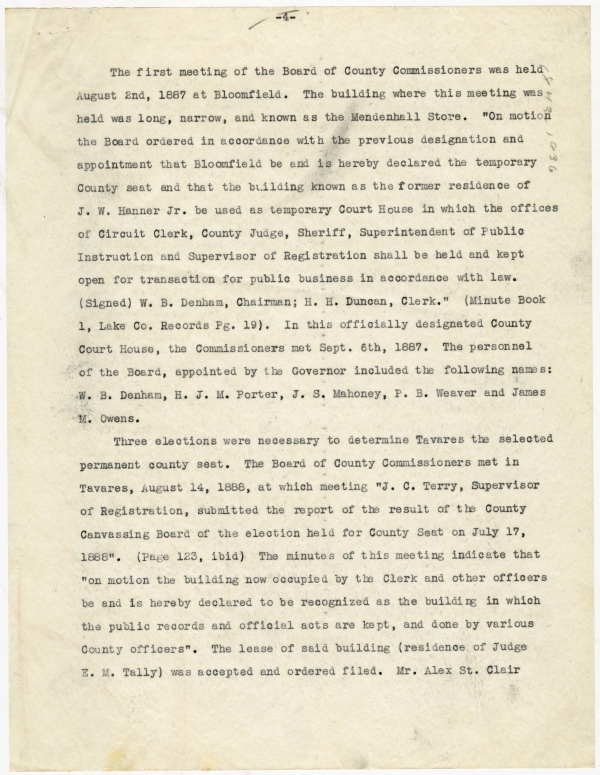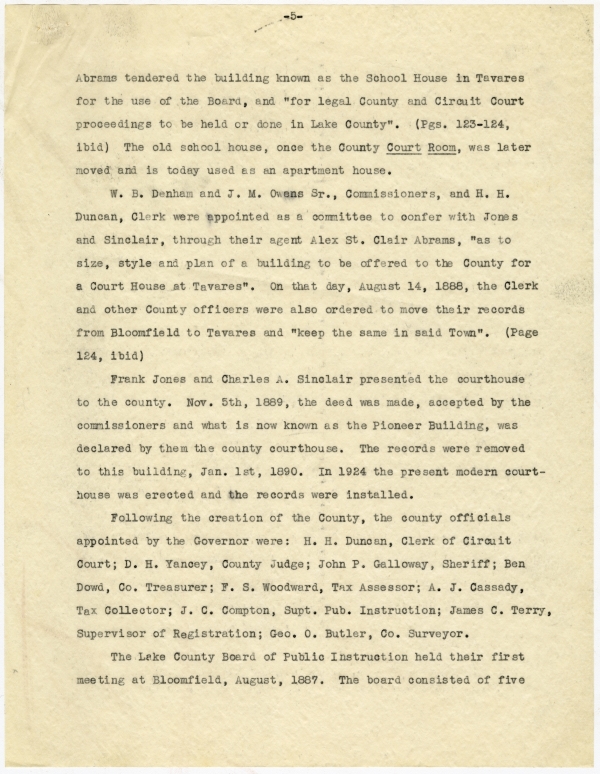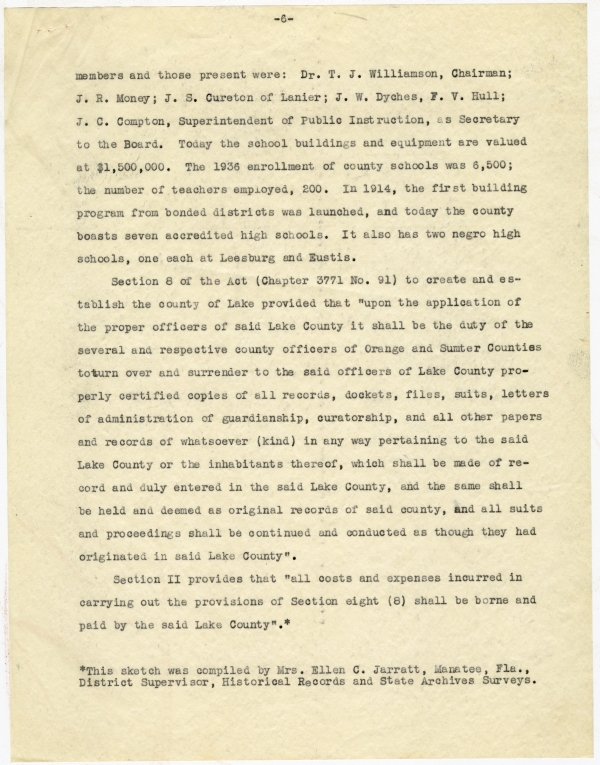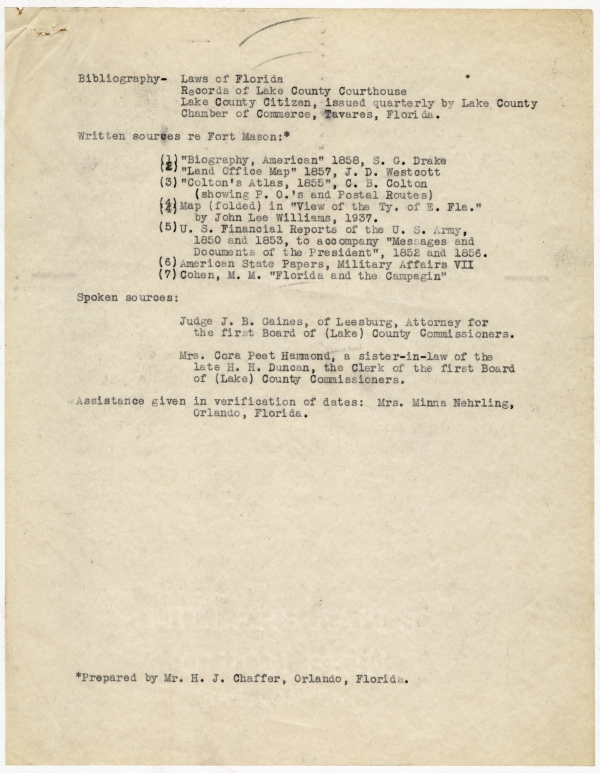Florida Memory is administered by the Florida Department of State, Division of Library and Information Services, Bureau of Archives and Records Management. The digitized records on Florida Memory come from the collections of the State Archives of Florida and the special collections of the State Library of Florida.

State Archives of Florida
- ArchivesFlorida.com
- State Archives Online Catalog
- ArchivesFlorida.com
- ArchivesFlorida.com
State Library of Florida
Related Sites
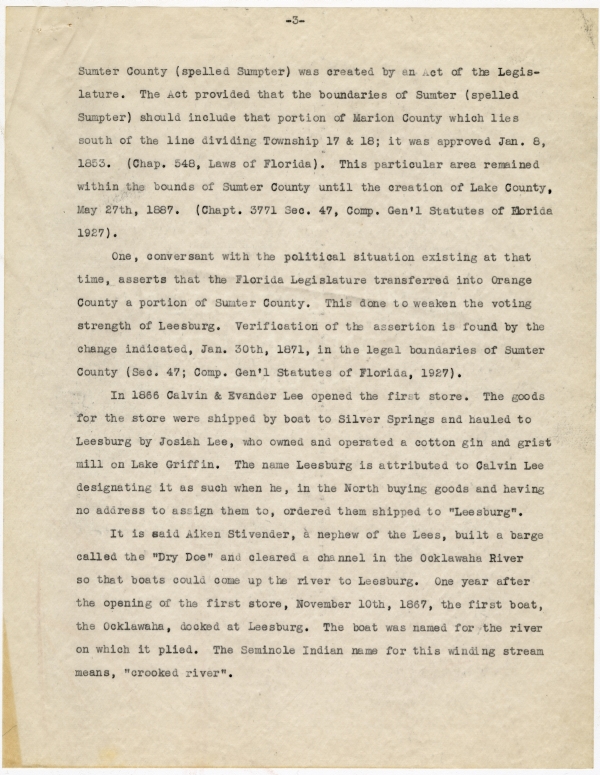
Description of previous item
Description of next item

Source
Description
Date
Contributors
Format
Coverage
Personal Subjects
Subjects
Geographic Term
Note to Researchers:
Though the WPA field workers included extensive citations for the factual information contained in these county histories, it should be noted that these historical narratives were produced in the 1930s by federal government employees, and might reflect the inherent social biases of the era.
-3-
Sumter County (spelled Sumpter) was created by an Act of the Legislature. The Act provided that the boundaries of Sumter (spelled Sumpter) should include that portion of Marion County which lies south of the line dividing Township 17 & 18; it was approved Jan. 8, 1853. (Chap. 548, Laws of Florida). This particular area remained within the bounds of Sumter County until the creation of Lake County, May 27th, 1887. (Chapt. 3771 Sec. 47, Comp. Gen'l Statutes of Florida 1927).
One, conversant with the political situation existing at that time, asserts that the Florida Legislature transferred into Orange County a portion of Sumter County. This done to weaken the voting strength of Leesburg. Verification of the assertion is found by the change indicated, Jan. 30th, 1871, in the legal boundaries of Sumter County (Sec. 47; Comp. Gen'l Statutes of Florida, 1927).
In 1866 Calvin & Evander Lee opened the first store. The goods for the store were shipped by boat to Silver Springs and hauled to Leesburg by Josiah Lee, who owned and operated a cotton gin and grist mill on Lake Griffin. The name Leesburg is attributed to Calvin Lee designating it as such when he, in the North buying goods and having no address to assign them to, ordered them shipped to "Leesburg".
It is said Aiken Stivender, a nephew of the Lees, built a barge called the "Dry Doe" and cleared a channel in the Ocklawaha River so that boats could come up the river to Leesburg. One year after the opening of the first store, November 10th, 1867, the first boat, the Ocklawaha, docked at Leesburg. The boat was named for the river on which it plied. The Seminole Indian name for this winding stream means, "crooked river".
Title
Subject
Description
Creator
Source
Date
Contributor
Format
Language
Type
Identifier
Coverage
Thumbnail
Geographic Term
ImageID
Subject - Person
Transcript
Submitted state office - April 5 - 1937
Letter of [?] J.B Gaines attached
" " " Cara Put Hammond - March 31st 1937
HISTORICAL SKETCH OF LAKE COUNTY
Senator George M. Lee of Leesburg, Sumter County, introduced in the Legislature, May 12, 1887, a bill to create and establish the county of Lake from portions of Sumter and Orange Counties. The bill was approved by Governor Edward A. Perry, May 27th 1887.*
Owing to the fact that approximately fourteen hundred lakes were embraced within the boundaries of the new county, "Lake" was fittingly chosen as a county name. One finds the picturesque Indian designations of the local waters quite in the minority. The early settlers apparently named the majority of the lakes for either their wives or daughters. Lakes Harris, Dot, Nettie, Minerva, Joanna, Florence, Dicie, Gertrude and Dora indicate a characteristic American atmosphere. Lake Harris was formerly known as "Lake Astatula", Indian for the lake of sunbeams. Lake Eustis was so named for Colonel Eustis of the U. S. Army, whose forces had a skirmish with the Indians during the Seminole War. Some authorities assert the site of this skirmish is near the southern end of the lake.
Section I of the Act creating the County of Lake gives the boundaries as follows: Beginning at the intersection of the range line dividing ranges twenty-three and twenty-four with the township line dividing townships twenty-four and twenty-five; thence east along said township line to the range line dividing ranges 26 and 27; thence north to the south shore of Lake Apopka; thence north across the waters of Lake Apopka, taking in all islands and peninsulas along the west shore of said lake to the north shore of Lake Apopka where it is intersected by the range line dividing ranges 26 and 27; thence
*Chapter 3771 No. 91, Acts.
-2-
north along said range line to the township line dividing township 19 and 20; thence east along said township line to the Wekiva River; thence north through the center of said Wekiva River to the St. Johns river; thence in a northerly and northwesterly direction through the center of the St. Johns river to the southwest shore of Lake George; thence north along the west shore of Lake George to the range line dividing ranges 26 and 27; thence south along said range line to the township line dividing townships 17 and 18; thence west along the said township line to the range line dividing ranges 23 and 24; thence south along the said range line to the place of beginning.*
Fort Mason, a temporary post of the Seminole War, was erected north of Lake Eustis near the old Indian trail from Volusia to Chuckuchatte (4) (2). Here Scott's left wing under Gen. Abraham Eustis camped, January 28, 1836, while his sappers under Lt. M. M. Cohen bridged the swollen Ocklawaha. They named their breast works "Camp Butler" after Lt. Col. P. M. Butler of the South Carolina Mounted Volunteers, the man who selected the site. (6) (7). Under Jesup in 1837, the camp was re-established and named Ft. Mason for a Lt. Col. Richard Barnes Mason of First Infantry (1), who succeeded L. Taylor as Col. of that regiment. (6) When the Ocklawaha was opened for navigation Ft. Mason became the distributing point for supplies furnished by the U. S. to settlers under the "Armed Settlement Act" of 1842. (5) In 1855, it was indicated as one of the two post offices of [Sumter] county. (3)
Leesburg, now the largest city in the county is also one of the oldest. The settlement was established by members of the Lee family who came as pioneers in 1849, into the locality then known as Marion County.
*The Compiled General Laws of the State of FLorida Vol. I show that the boundaries as set forth May 27, 1887 were modified, i.e., Ch. 3944, May 31, 1889; as amended by Ch. 4066, Acts 1891.
-3-
Sumter County (spelled Sumpter) was created by an Act of the Legislature. The Act provided that the boundaries of Sumter (spelled Sumpter) should include that portion of Marion County which lies south of the line dividing Township 17 & 18; it was approved Jan. 8, 1853. (Chap. 548, Laws of Florida). This particular area remained within the bounds of Sumter County until the creation of Lake County, May 27th, 1887. (Chapt. 3771 Sec. 47, Comp. Gen'l Statutes of Florida 1927).
One, conversant with the political situation existing at that time, asserts that the Florida Legislature transferred into Orange County a portion of Sumter County. This done to weaken the voting strength of Leesburg. Verification of the assertion is found by the change indicated, Jan. 30th, 1871, in the legal boundaries of Sumter County (Sec. 47; Comp. Gen'l Statutes of Florida, 1927).
In 1866 Calvin & Evander Lee opened the first store. The goods for the store were shipped by boat to Silver Springs and hauled to Leesburg by Josiah Lee, who owned and operated a cotton gin and grist mill on Lake Griffin. The name Leesburg is attributed to Calvin Lee designating it as such when he, in the North buying goods and having no address to assign them to, ordered them shipped to "Leesburg".
It is said Aiken Stivender, a nephew of the Lees, built a barge called the "Dry Doe" and cleared a channel in the Ocklawaha River so that boats could come up the river to Leesburg. One year after the opening of the first store, November 10th, 1867, the first boat, the Ocklawaha, docked at Leesburg. The boat was named for the river on which it plied. The Seminole Indian name for this winding stream means, "crooked river".
-4-
The first meeting of the Board of County Commissioners was held August 2nd, 1887 at Bloomfield. The building where this meeting was held was long, narrow, and known as the Mendenhall Store. "On motion the Board ordered in accordance with the previous designation and appointment that Bloomfield be and is hereby declared the temporary County seat and that the building known as the former residence of J. W. Hanner Jr. be used as temporary Court House in which the offices of Circuit Clerk, County Judge, Sheriff, Superintendent of Public Instruction and Supervisor of Registration shall be held and kept open for transaction for public business in accordance with law. (Signed) W. B. Denham, Chairman; H. H. Duncan, Clerk." (Minute Book 1, Lake Co. Records Pg. 19). In this officially designated County Court House, the Commissioners met Sept. 6th, 1887. The personnel of the Board, appointed by the Governor included the following names: W. B. Denham, H. J. M. Porter, J. S. Mahoney, P. B. Weaver and James M. Owens.
Three elections were necessary to determine Tavares the selected permanent county seat. The Board of County Commissioners met in Tavares, August 14, 1888, at which meeting "J. C. Terry, Supervisor of Registration, submitted the report of the result of the County Canvassing Board of the election held for County Seat on July 17, 1888". (Page 123, ibid) The minutes of this meeting indicate that "on motion the building now occupied by the Clerk and other officers be and is hereby declared to be recognized as the building in which the public records and official acts are kept, and done by various County officers". The lease of said building (residence of Judge E. M. Tally) was accepted and ordered filed. Mr. Alex St. Clair
-5-
Abrams tendered the building known as the School House in Tavares for the use of the Board, and "for legal County and Circuit Court proceedings to be held or done in Lake County". (Pgs. 123-124, ibid) The old school house, once the County Court Room, was later moved and is today used as an apartment house.
W. B. Denham and J. M. Owens Sr., Commissioners, and H. H. Duncan, Clerk were appointed as a committee to confer with Jones and Sinclair, through their agent Alex St. Clair Abrams, "as to size, style and plan of a building to be offered to the County for a Court House at Tavares". On that day, August 14, 1888, the Clerk and other County officers were also ordered to move their records from Bloomfield to Tavares and "keep the same in said Town". (Page 124, ibid)
Frank Jones and Charles A. Sinclair presented the courthouse in the county. Nov 5th, 1889, the deed was made, accepted by the commissioners and what is now known as the Pioneeer Building, was declared by them the county courthouse. The records were removed to this building, Jan. 1st, 1890. In 1924 the present modern courthouse was erected and the records were installed.
Following the creation of the County, the county officials appointed by the Governor were: H. H. Duncan, Clerk of Circuit Court; D. H. Yancey, County Judge; John P. Galloway, Sheriff; Ben Dowd, Co. Treasurer; F. S. Woodward, Tax Assessor; A. J. Cassady, Tax Collector; J. C. Compton, Supt. Pub. Instruction; James C. Terry, Supervisor of Registration; Geo. O. Butler, Co. Surveyor.
The Lake County Board of Public Instruction held their first meeting at Bloomfield, August, 1887. The board consisted of five
-6-
members and those present were: Dr. T. J. Williamson, Chairman; J. R. Money; J. S. Cureton of Lanier; J. W. Dyches, F. V. Hull; J. C. Compton, Superintendent of Public Instruction, as Secretary to the Board. Today the school buildings and equipment are valued at $1,500,000. The 1936 enrollment of county schools was 6,500; the number of teachers employed, 200. In 1914, the first building program from bonded districts was launched, and today the county boasts seven accredited high schools. It also has two negro high schools, one each at Leesburg and Eustis.
Section 8 of the Act (Chapter 3771 No. 91) to create and establish the county of Lake provided that "upon the application of the proper officers of said Lake County it shall be the duty of the several and respective county officers of Orange and Sumter Counties to turn over and surrender to the said officers of Lake County properly certified copies of all records, dockets, files, suits, letters of administration of guardianship, curatorship, and all other papers and records of whatsoever (kind) in any way pertaining to the said Lake County or the inhabitants thereof, which shall be made of record and duly entered in the said Lake County, and the same shall be held and deemed as original records of said county, and all suits and proceedings shall be continued and conducted as though they had originated in said Lake County".
Section II provides that "all costs and expenses incurred in carrying out the provisions of Section eight (8) shall be borne and paid by the said Lake County".*
*This sketch was compiled by Mrs. Ellen C. Jarratt, Manatee, Fla., District Supervisor, Historical Records and State Archives Surveys.
Bibliography- Laws of Florida
Records of Lake County Courthouse
Lake County Citizen, issued quarterly by Lake County Chamber of Commerce, Tavares, Florida.
Written sources re Fort Mason:*
(1) "Biography, American" 1858, S. G. Drake
(2) "Land Office Map" 1857, J. D. Westcott
(3) "Colton's Atlas, 1855", C. B. Colton
(4) Map (folded) in "View of the Ty. of E. Fla." by John Lee Williams, 1937.
(5) U. S. Financial Reports of the U. S. Army, 1850 and 1853, to accompany "Messages and Documents of the President", 1852 and 1856.
(6) American State Papers, Military Affairs VII
(7) Cohen, M. M. "Florida and the [Campaign]"
Spoken sources:
Judge J. B. Gaines, of Leesburg, Attorney for the first Board of (Lake) County Commissioners.
Mrs. Cora Peet Hammond, a sister-in-law of the late H. H. Duncan, the Clerk of the first Board of (Lake) County Commissioners.
Assistance given in verification of dates: Mrs. Minns Nehrling, Orlando, Florida.
*Prepared by Mr. H. J. Chaffer, Orlando, Florida.
Chicago Manual of Style
Works Progress Administration, Historical Records Survey. Historical Sketch of Lake County. March 31, 1937. State Archives of Florida, Florida Memory. <https://www.floridamemory.com/items/show/321124>, accessed 18 December 2025.
MLA
Works Progress Administration, Historical Records Survey. Historical Sketch of Lake County. March 31, 1937. State Archives of Florida, Florida Memory. Accessed 18 Dec. 2025.<https://www.floridamemory.com/items/show/321124>
AP Style Photo Citation
(State Archives of Florida/Works Progress Administration)

 Listen: The Latin Program
Listen: The Latin Program